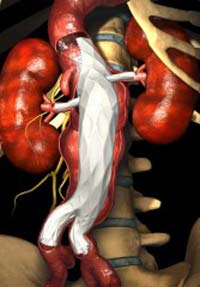New Stent Graft Could Allow Repair of Aneurysms Involving Both the Aorta and Renal Arteries

Courtesy of Endologix Inc<br>The Ventana stent graft system
What distinguishes the new device system is that it is has a main column intended to protect the aorta and exclude the aneurysm from blood flow and two offshoot devices intended to protect the two renal arteries. The device is not commercially available in the United States, and will only be available at selected clinical study sites for investigational use.
“These devices could allow management of aortic aneurysms that extend up to and may involve the renal arteries,” said Methodist DeBakey Heart & Vascular Center Medical Director Alan Lumsden, M.D., who is leading the trial at Methodist. “They permit branches to be inserted through the main device and into the renal arteries in order to maintain blood flow to the kidneys. This has not been part of currently available devices. The device is meant to address the needs of patients whose aortic aneurysms are more extensive.”
Stent grafts are light, metal-frame cylinders surrounded by a cloth-like covering. Similar devices are used to strengthen and protect blood vessels that have developed aneurysms — weakened to the point that rupture, or dissection, is possible. An aneurysm is a weakening or ballooning in a blood vessel wall.
The aorta extends up and out of the heart and down to the lower back. Abdominal aortic aneurysm (AAA) is a weakening of the lower half of the aorta. That weakening may cause the aorta to bow outward, as if swollen, or even to develop a bubble. If the aneurysm dissects, blood spills into the body. The lost blood supply to the brain and other important organs is usually deadly.
The Ventana stent graft system received an investigational device exemption (IDE) conditional approval from the United States Food and Drug Administration recently for the purpose of evaluating its safety and feasibility in treating certain types of abdominal aortic aneurysms that are near to or may involve the renal arteries. In November, Methodist will be the procedural training site for medical researchers participating in the national feasibility study. A pivotal trial will also be conducted at these and additional research sites.
Many patients have aneurysms that extend from the aorta into one or both of the arteries that lead to the kidneys, organs that help the body remove toxins and that help regulate blood pressure. Keeping those aneurysms from rupturing is of great concern, Lumsden says.
“The open repair of aneurysms involving the renal arteries is called a juxtarenal, pararenal, or thoracoabdominal aneurysm repair,” Lumsden said. “This has involved opening both the chest and abdomen at the same time and represents one of the largest procedures we ever perform. Many patients are just not able to tolerate the operation. In those who undergo surgery the complication rate is high and the recovery very difficult. We're hopeful this new device will permit an endovascular treatment to be extended to a much bigger group of patients.”
Lumsden is also chair of Methodist's Department of Cardiovascular Surgery, a professor of cardiothoracic surgery in the Cornell University Weill Cornell Medical College, and a fellow of the American College of Surgeons.
Endologix Inc. develops and manufactures minimally invasive treatments for aortic disorders. Additional information about the company can be found at http://www.endologix.com.
Journalists interested in speaking with Dr. Lumsden should contact David Bricker, The Methodist Hospital, at 832-667-5811 or dmbricker@tmhs.org
Media Contact
More Information:
http://www.tmhs.orgAll latest news from the category: Medical Engineering
The development of medical equipment, products and technical procedures is characterized by high research and development costs in a variety of fields related to the study of human medicine.
innovations-report provides informative and stimulating reports and articles on topics ranging from imaging processes, cell and tissue techniques, optical techniques, implants, orthopedic aids, clinical and medical office equipment, dialysis systems and x-ray/radiation monitoring devices to endoscopy, ultrasound, surgical techniques, and dental materials.
Newest articles

Superradiant atoms could push the boundaries of how precisely time can be measured
Superradiant atoms can help us measure time more precisely than ever. In a new study, researchers from the University of Copenhagen present a new method for measuring the time interval,…

Ion thermoelectric conversion devices for near room temperature
The electrode sheet of the thermoelectric device consists of ionic hydrogel, which is sandwiched between the electrodes to form, and the Prussian blue on the electrode undergoes a redox reaction…

Zap Energy achieves 37-million-degree temperatures in a compact device
New publication reports record electron temperatures for a small-scale, sheared-flow-stabilized Z-pinch fusion device. In the nine decades since humans first produced fusion reactions, only a few fusion technologies have demonstrated…





















